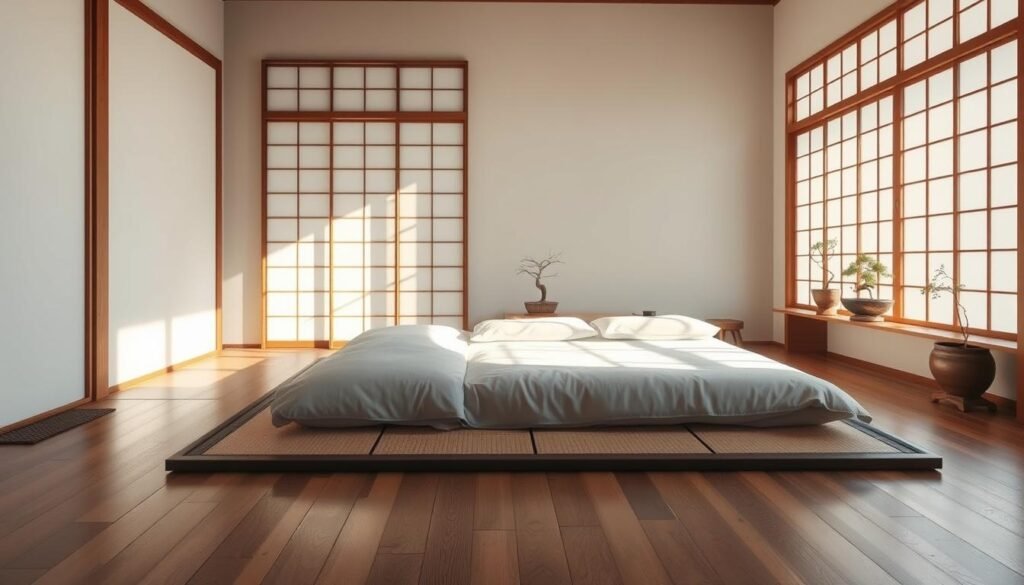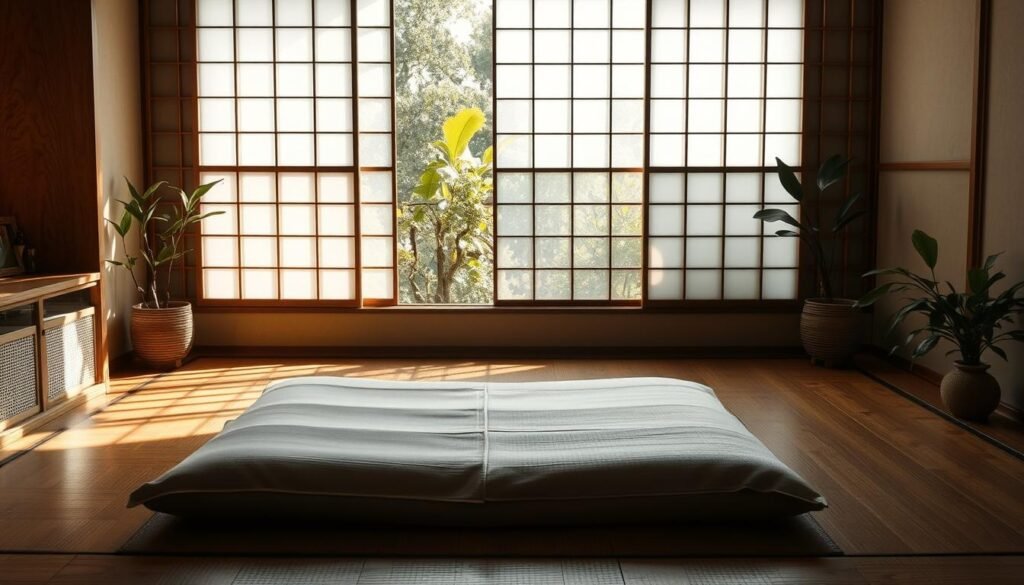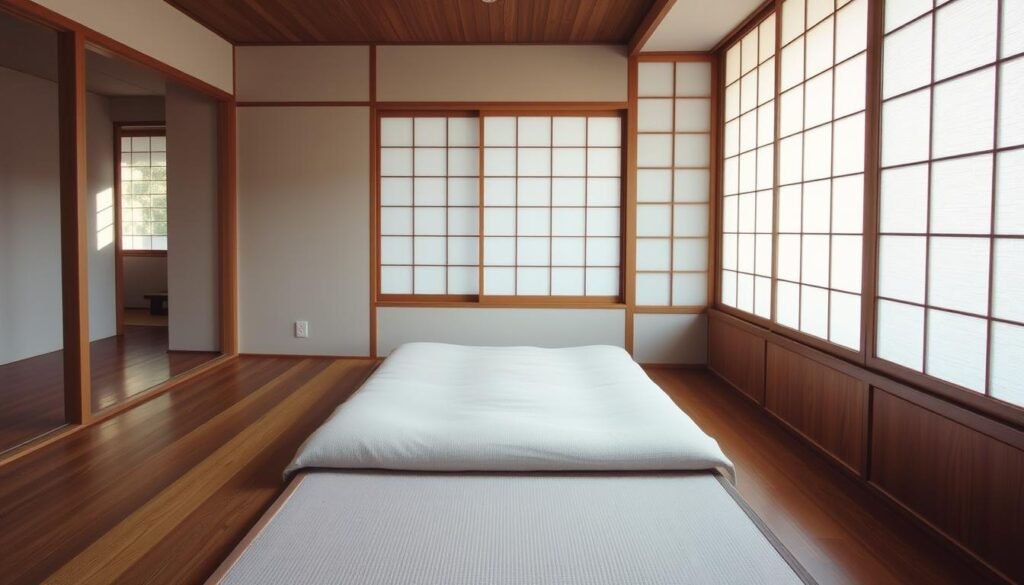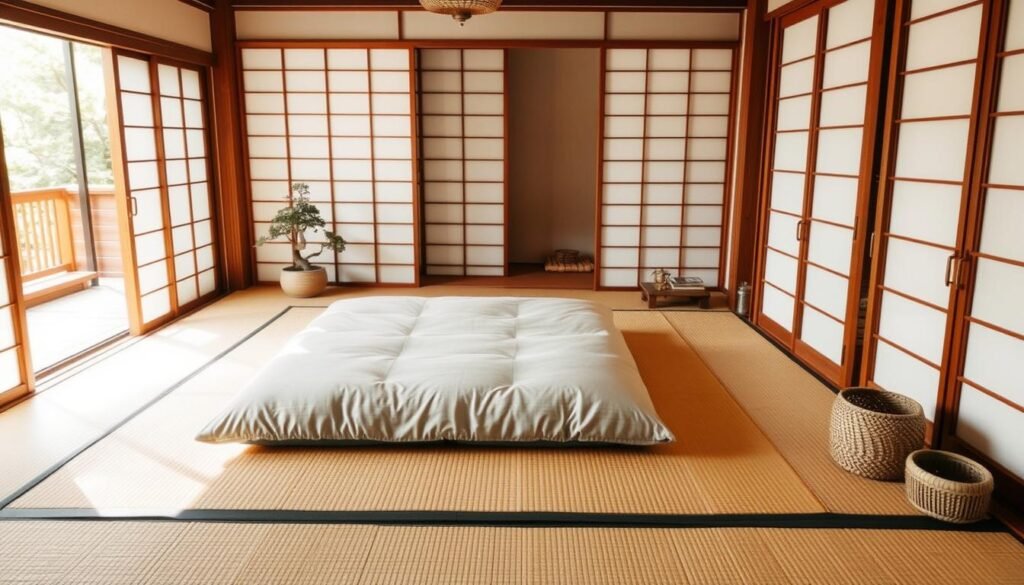Did you know Japanese futon mattresses are often called Tatami mats1? But, Tatami mats are actually traditional straw floor mats used in Japan for centuries1. They offer benefits like better back pain, circulation, and less fatigue and stress1. Yet, they also have some downsides to think about. In this guide, we’ll explore the good and bad of using a Tatami mattress.
Tatami mats soak up moisture, keeping it from harming your floors1. They can also help you feel less tired1. Plus, they’re easy to fold or move when not in use, saving space1. Their traditional design can also make your home look unique.
Key Takeaways
- Tatami mats are traditional Japanese floor mats, not futon mattresses
- Tatami mats can improve back pain, circulation, and reduce fatigue and stress
- Tatami mats are more affordable than a regular mattress
- Tatami mats may not be suitable for those with poor mobility or certain spine conditions
- Proper care and maintenance are essential for Tatami mats to prevent issues like mold and dust mites
Introduction to Tatami Mattresses
Tatami mattresses come from Japan and are known worldwide. They are made from woven rush grass and rice straw. This makes them firm and different from Western mattresses2.
What are Tatami Mattresses?
Tatami mattresses, or futons, are key in Japan’s sleep culture. They are about three to four inches thick. They have a cotton fill inside a cotton cover3.
The traditional makura pillow, small and filled with buckwheat or beans, adds to the sleep experience2.
Understanding the Difference Between Tatami Mats and Mattresses
Tatami mats and mattresses are not the same. Tatami mats are woven floor mats used alone or with a mattress. A tatami mattress is the whole sleeping area, sometimes using mats as its base3.
The Japanese sleep system is flexible. Families often share a tatami room with two or three futons for parents and kids3.
Pros of Using a Tatami Mattress
Tatami mattresses are great for many reasons. They have a firm, flat surface that helps keep your spine straight. This can help reduce back pain45. They also use natural materials like rice straw or rush grass. These can help improve blood flow and keep your body cool6.
They also have practical benefits. Tatami mattresses are low-profile and take up less space. This makes them perfect for small rooms4. Plus, they’re often cheaper than regular beds, which is good for your wallet5.
Improve Back Pain, Circulation, and More
The firm surface of a tatami mattress helps keep your spine aligned. This can reduce back pain56. The natural materials also help with blood flow and keep you cool. This makes for a more comfortable sleep46.
Reduce Fatigue
Using a tatami mattress can make you feel less tired. It provides a supportive and comfy surface for your body. The design spreads out your weight evenly, which helps with blood flow56.
Save Space in Your Home
Tatami mattresses are great for small spaces. They’re low-profile and easy to store. Their simple design also fits well with many bedroom styles45.

“Sleeping close to the floor on a tatami mat can help with maintaining proper spinal alignment and posture during sleep, particularl beneficial for individuals seeking firm sleeping surfaces.”6
tatami mattress pros and cons
There are many things to think about when deciding on a tatami mattress. They offer great back support, better circulation, and a natural sleep feel7. But, they might not be right for everyone, depending on your sleep style or physical needs7.
Tatami mattresses are known for being firm and supportive. They are usually 55mm to 60mm thick7. Modern ones can be 1 to 3 inches thick7. This firmness helps keep your spine straight and can ease back pain for many people7. The space between the wooden slats also lets air flow, making sleep more refreshing7.
Another big plus is that tatami mattresses are eco-friendly. They’re made from natural stuff like rice straw and rush grass7. This makes them a green choice and can help with allergies, too.
| Pros | Cons |
|---|---|
Despite their benefits, tatami mattresses have some downsides. Some people might find them too hard, which can be a problem for side or stomach sleepers7. It can also take some getting used to, as your body adjusts to the new support7.
Choosing a tatami mattress depends on what you need and like. Weighing the good and bad points can help you decide if it’s right for you789.

Cons of Using a Tatami Mattress
Tatami mattresses have many benefits, but they also have some downsides. One major issue is that they might not be comfortable for side sleepers10. The firm surface can cause pressure on the hips and shoulders, leading to discomfort and sleep problems.
Another problem is that tatami mattresses are not good for people with mobility issues or certain spine conditions10. Getting up from the floor can be hard, which might be a safety risk11. Senior citizens might prefer the ease of getting in and out of a traditional bed.
It’s key to remember that tatami mattresses are popular in Japan12. But, whether they’re right for you depends on your personal needs and health. People with certain medical issues or mobility problems might prefer a traditional mattress12.

In short, using a tatami mattress might not be ideal for everyone. Side sleepers and those with mobility issues should think carefully before switching101112.
Tips for Optimal Use of Tatami Mattresses
To get the most out of your tatami mattress, think about where and how you care for it. A few easy steps can help your mattress last longer and work better.
Place the Mat in an Area Where You Spend a Lot of Time
Choosing the right spot for your tatami mattress can boost its benefits. Put it in a place you often hang out, like a living room or office13. This lets you enjoy the Japanese sleep system all day, improving your circulation and reducing back pain13.
Make Sure to Keep the Mat Clean and Free of Dust and Dirt
Keeping your tatami mattress clean is key to its long life and good performance. Clean it often to avoid dust, dirt, and mold13. This keeps the mat fresh and healthy, ensuring a clean and comfy sleep.
For those with small spaces, tatami mattresses are a great option13. They come in different types, like shikifutons and kakebutons, which are thin and hypoallergenic13. Buckwheat hull pillows offer adjustable comfort, showing the flexibility of the Japanese sleep system13.
The Japanese sleep system is becoming more popular worldwide13. By placing your tatami mattress wisely and caring for it well, you can enjoy its unique benefits fully13.
Popular Tatami Mattress Options
Looking for the best tatami mattresses? There are many great options out there. Tatami mattresses are loved for their support, comfort, and eco-friendly materials14.
Traditional tatami mattresses use natural materials like straw or rice husk. This makes them a green choice for your bed14. Modern tatami mattresses also use foam, cotton, and latex, appealing to more people14.
Want a budget-friendly option? Affordable tatami mattresses are a smart pick14. They’re cheaper than regular beds but last long, making them a good value14.
Size matters, and tatami mattresses come in many sizes15. Queen-size beds need three mats, while king-size beds require four and a half15. You can also find single or double sizes, or even custom sizes to fit your space15.
Whether you like traditional Japanese mats or modern designs, there’s a tatami mattress for you14. Think about the material, thickness, and size to find the perfect one for your sleep and home14.

Tatami mattresses are not just for sleeping. They’re great for meditation, yoga, or as sitting cushions14. Their durability, eco-friendliness, and health benefits make them popular worldwide14.
Conclusion
We’ve looked into tatami mattresses and found both good and bad points16. Japanese futons have been loved in Japan for ages and are now popular in the West17. They can last 5 to 10 years with regular use, and Western ones are now more stylish and comfy18.
The Shikibuton, a Japanese futon, is thinner and rectangular. It’s soft yet firm, fitting your body for better sleep and spine alignment18.
People like tatami mattresses for their simple look, health benefits, and space-saving design16. But, some find them too hard, while others love the luxury of using them with futon covers18. The quality of the material, how well you take care of it, and your personal sleep style are key to enjoying a tatami mattress.
Choosing a tatami mattress depends on your sleep needs, health, and living space18. Shikibutons are small, affordable, and cozy, but might not keep you warm in cold places. Always talk to health experts and think about your situation before deciding. Knowing the good and bad of tatami mattresses helps you decide if they’re right for you.
FAQ
What are the key benefits of using a tatami mattress?
Are tatami mattresses suitable for side sleepers?
How do I maintain a tatami mattress?
What are the differences between tatami mats and tatami mattresses?
Are tatami mattresses suitable for people with poor mobility or certain spine conditions?
What are some popular and well-reviewed tatami mattress options?
Source Links
- The Pros and Cons of Japanese Floor Mats For Sleep | BetterSleep – https://www.bettersleep.com/blog/the-pros-and-cons-of-japanese-floor-mats-for-sleep
- The Pros and Cons of the Japanese Futon – Asian Lifestyle Design – https://asianlifestyledesign.com/2010/08/the-pros-and-cons-of-the-japanese-futon/
- A Complete Guide to the Japanese Sleep System – https://jlifeinternational.com/blogs/news/a-complete-guide-to-the-japanese-sleep-system?srsltid=AfmBOoqx5KH9ekBT5CIkElScg4-AvphVdUheb2M8WJRsecI6TbiCU6ya
- Tatami Mats Advantages and Disadvantages – Interra USA – https://interra-usa.com/tatami-mats-advantages-and-disadvantages/
- What is a Tatami Mattress and Is It Good? – https://www.ecosa.com.au/blog/post/what-is-a-tatami-mattress-and-is-it-good.html
- Sleeping On a Tatami Mat – What You Need to Know (Benefits and Drawbacks) – https://www.sleepline.com/sleeping-on-a-tatami-mat/
- Are Tatami beds good for you? – https://solidcustomheirlooms.com/are-tatami-beds-good-for-you/
- A Complete Guide to the Japanese Sleep System – https://jlifeinternational.com/blogs/news/a-complete-guide-to-the-japanese-sleep-system?srsltid=AfmBOor8T0jS_HyyVUKBfPcNcJu28uDd_qDCkvwHR3RQcmdioU7Htz6N
- I’ve Never Slept Better Than on a Japanese Futon – https://www.nytimes.com/wirecutter/blog/japanese-futon/
- What are Japanese floor mattresses and are they healthy to sleep on? – https://www.tomsguide.com/reference/what-are-japanese-floor-mattresses-and-are-they-healthy-to-sleep-on
- Do I need Tatami Mats? What Should Go Under My Futon? – https://www.futonbedsfromjapan.com/futonblog/tatami-mats-carpet-wood-flooring-futon/
- Are Japanese Futons Good or Bad for Your Back and Why? – https://www.maxyoyohome.com/blogs/news/p-are-japanese-futons-good-or-bad-for-your-back-and-why?srsltid=AfmBOoqnbejl9fkXM4CCrCrrgFe8qdwWl8p12E_N8yAWESvs2SoooLJj
- A Complete Guide to the Japanese Sleep System – https://jlifeinternational.com/blogs/news/a-complete-guide-to-the-japanese-sleep-system?srsltid=AfmBOooiCwnJN4oVnbYyhKq1uekeDcQZHmQ9pc4i2ce62XybGwPql2Sq
- What is a Tatami Mattress and Is It Good? – https://www.ecosa.com.au/blog/post/what-is-a-tatami-mattress-and-is-it-good.html?srsltid=AfmBOoqLrtF1g5Sc8Zej5dzSV8lNa53bLPZoSkCoZFSnobZ9sCDh1uvL
- How To Use Tatami Mats With A Futon & A Mattress – https://tatami.us/blogs/articles/using-tatami-mats-with-a-futon-or-mattress
- Are Japanese Futons Good or Bad for Your Back and Why? – https://www.maxyoyohome.com/blogs/news/p-are-japanese-futons-good-or-bad-for-your-back-and-why?srsltid=AfmBOooTrqmS5no38LDOdlnTPf9A1UeUg4738ItmP5Ewv5VemTuI3gxi
- Futon Vs. Mattress: The Ultimate Comparison Guide – https://www.sleepjunkie.com/futon-vs-mattress/
- What is a Shikibuton? – https://fulijapan.com/blogs/blogs/what-is-a-shikibuton?srsltid=AfmBOooxILFD7U0_7TFjuABUHIax4jJLBEQznTu-_H9nkP4oJeOFd1mJ
